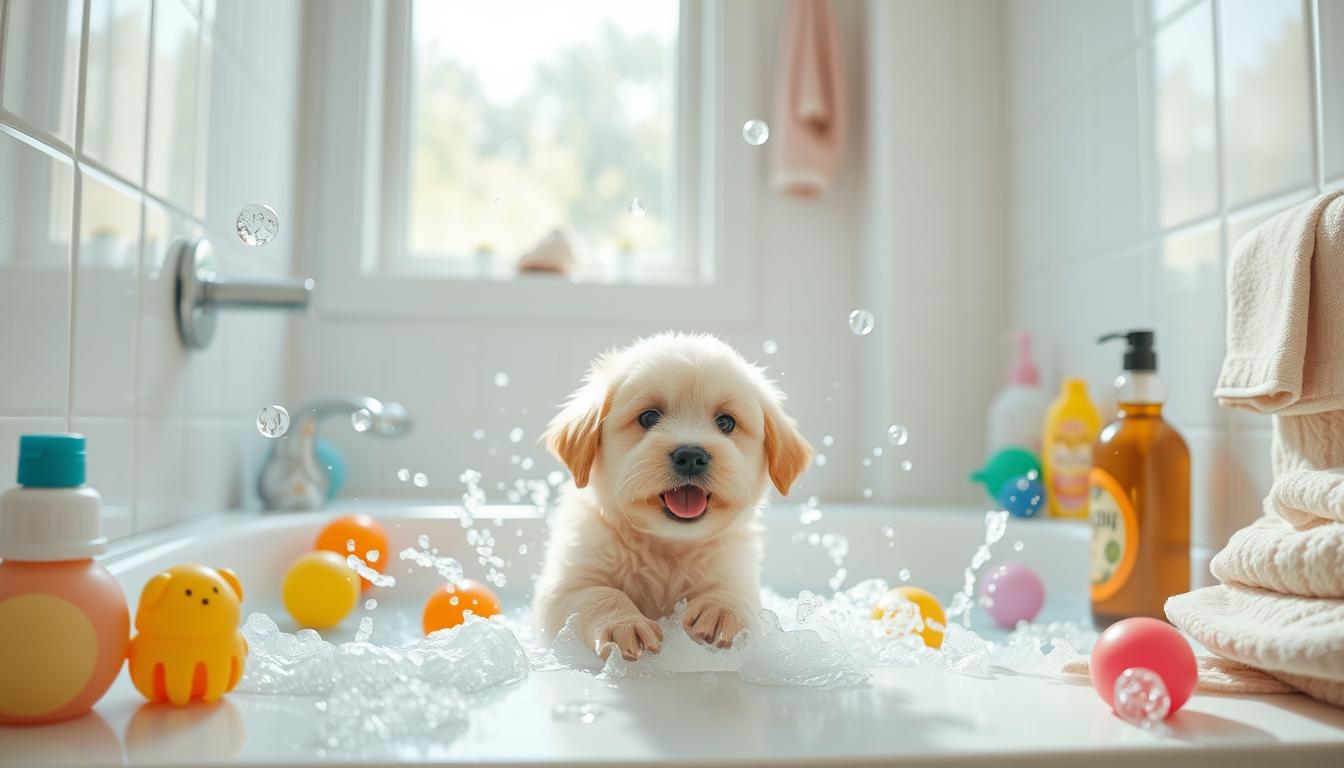Puppies bring joy and happiness into our lives. But, they need a little care, especially when it’s time for a bath. Jennifer Bishop-Jenkins, a top groomer, has some great tips to make bath time fun for you and your dog. But, you might be wondering, how young is too young to start bathing your puppy?
Key Takeaways
- Start bathing your puppy as early as 8-10 weeks old to establish a lifelong grooming routine.
- Bathe your puppy once a month to avoid stripping natural oils from their coat.
- Use specialised puppy shampoo and conditioner to keep their sensitive skin healthy.
- Introduce baths gradually with treats and cuddles to make it a positive experience.
- Proper drying techniques, like towel drying and low-heat blow drying, are essential.
Determine Your Puppy’s Coat Type
Before you get your dog wet, it’s important to choose the right shampoo and conditioner. This choice depends on your puppy’s fur type. Always ask your vet for advice on the best products for your puppy’s coat.
Some puppies need more minerals, while others need more oil. Long-coated dogs often benefit from moisturising products. Your vet can help find the perfect puppy shampoo and puppy conditioner for your puppy’s puppy coat type.
| Coat Type | Grooming Needs | Recommended Products |
|---|---|---|
| Long, Curly Coat (e.g. Poodles, Doodles, Bichons) | Require professional grooming every 2-3 weeks to prevent matting | Moisturising puppy shampoo and puppy conditioner with humectants |
| Long, Straight Coat (e.g. Maltese, Yorkies, Spaniels) | May need professional grooming to prevent excess length and matting | Nourishing puppy shampoo and puppy conditioner with added minerals |
| Short, Smooth Coat | Easier to maintain at home, may only need professional dog grooming products every 4-6 weeks | Gentle, oil-based puppy shampoo and puppy conditioner |
Working with your vet is key to finding the right puppy shampoo, puppy conditioner, and dog grooming products for your puppy. This ensures their coat stays healthy and easy to manage as they grow.
Provide Treats and Cuddles
Start bathing your puppies as young as eight weeks old. This helps create a lifelong puppy bath routine. Use treats, swaddling, and cuddling to make them feel safe and comfortable.
Puppies should get used to bathing and grooming around 8-10 weeks old. Washing them once a month helps keep their coat healthy. Dry, flaky skin or a brittle coat might mean they need a different shampoo. Regular brushing also helps manage shedding and keeps their coat looking good between baths.
Start bathing a new puppy after 8 weeks and bathe them at least once a month after that. They can go to the groomer for more grooming when they’re 10-12 months old. Some puppies might get anxious before their first bath. So, use positive reinforcement and socialise them slowly to the process.
Bathing too much can dry out their coats or cause skin problems. Wait until they’re at least 8 weeks old to bathe them. Then, bathe them once a month. Bathing keeps their coat and fur clean and healthy.
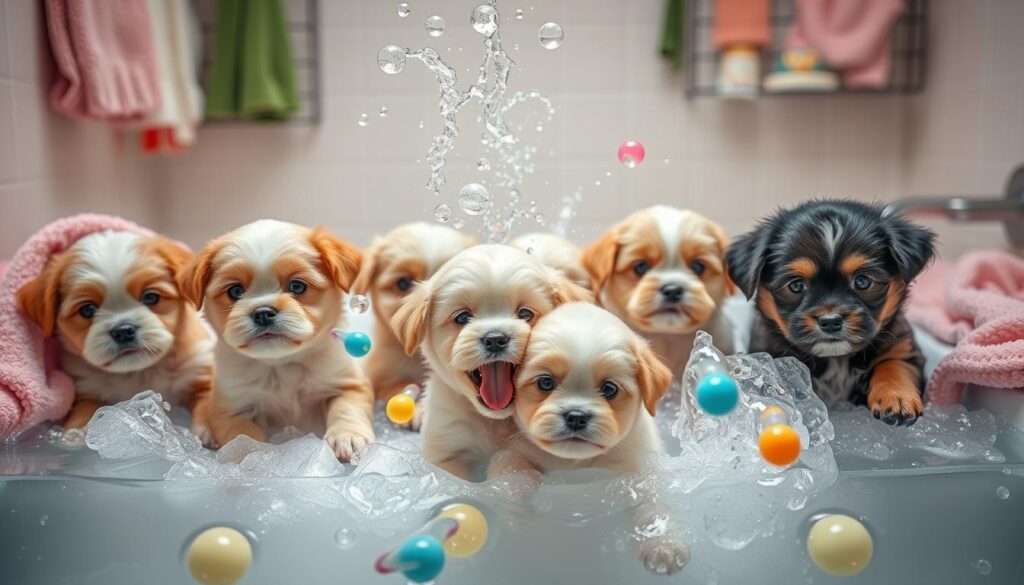
“We let the puppy run loose,” explains Bishop-Jenkins. “We put them up on the table, put on a loud clipper, and run a light brush over them. There’s lots of treats, swaddling, and cuddling. We make them feel safe.”
Start With Lukewarm Water and a Rag
When bathing young puppies, a warm washcloth is all you need. Pet grooming expert Emma Bishop-Jenkins says, “Until the dog is three or four months old, all you really need to use is a warm wash rag. Dogs’ body temperatures run higher than ours, so their experience with temperature is different from ours.”
Puppies should be at least 8 weeks old before their first bath. This ensures they’ve adjusted to their environment and have a strong immune system. It’s best to wait until their eyes and ears are fully open and their teeth are coming in.
The water for puppy baths should be lukewarm to avoid burns or chills. Their sensitive skin needs gentle care. Age and developmental milestones are key in determining the right time and frequency for baths. Use puppy-specific shampoos without harsh chemicals to keep their skin healthy.
“Dogs’ body temperatures run higher than ours, so their experience with temperature is different from ours.”
When bathing puppies, use gentle washing, rinsing, and drying techniques. This ensures a positive experience. You’ll need non-slip mats, gentle combs, towels, and grooming tools. Positive reinforcement with treats and praise helps make bath time enjoyable for puppies.
Use lukewarm water to wash dogs to avoid distress and health risks. Overwashing can cause dry skin by stripping away natural oils. It’s not good to bathe dogs every day. Dogs have a more neutral pH balance than humans, so human shampoo can harm their skin.
Dogs need to be dried thoroughly after a bath, especially those with thick coats. This prevents skin conditions like acute moist dermatitis. Puppies shouldn’t be bathed daily. It’s safe to start bathing them at eight weeks old, but always check product labels for age suitability. If unsure, consult a vet or pet stylist.
Graduate to Using Shampoo
When your puppy is at least three months old, it’s time for dog-safe shampoo and conditioner. Choose products that match your puppy’s skin type. Stay away from cheap shampoos with harsh chemicals that can harm your puppy’s skin.
Pet grooming expert Samantha Bishop-Jenkins advises, “Pick shampoos and conditioners made for dogs and pH balanced. And avoid the cheapest options. Instead, opt for professional-grade products.”
Look for puppy shampoos with natural ingredients and no harsh additives. These professional grooming products clean your puppy’s coat while keeping their skin healthy. They use natural oils to keep your puppy’s skin in good shape.
“Select shampoos and conditioners that are made for dogs and pH balanced. And don’t buy the cheapest thing out there. I talk to professionals about getting the best professional type that I can get.”
Switching to a dog-safe shampoo makes bath time better for your puppy. The right puppy shampoo keeps your puppy’s coat and skin healthy. It’s all about gentle care.
Be Gentle
Bathing a puppy under six months old is like bathing a human baby. Puppies are not used to water and handling. It’s important to be very gentle during bath time.
Use soft water and gentle hand motions that follow their hair growth. Avoid harsh scrubbing or aggressive movements. These can scare and upset your puppy. Remember, puppy bath techniques should focus on dog grooming gentleness for a positive bath experience.
“Bathing a puppy under six months old is very comparable to bathing a human infant,” says Veterinarian Dr. Emma Bishop-Jenkins. “Puppies, like babies, aren’t used to the feeling. They can’t protect themselves, so you need to be extra gentle.”
Take your time and introduce your puppy to the bath gradually. Give lots of praise, treats, and cuddles. This helps them feel comfortable with bath time.
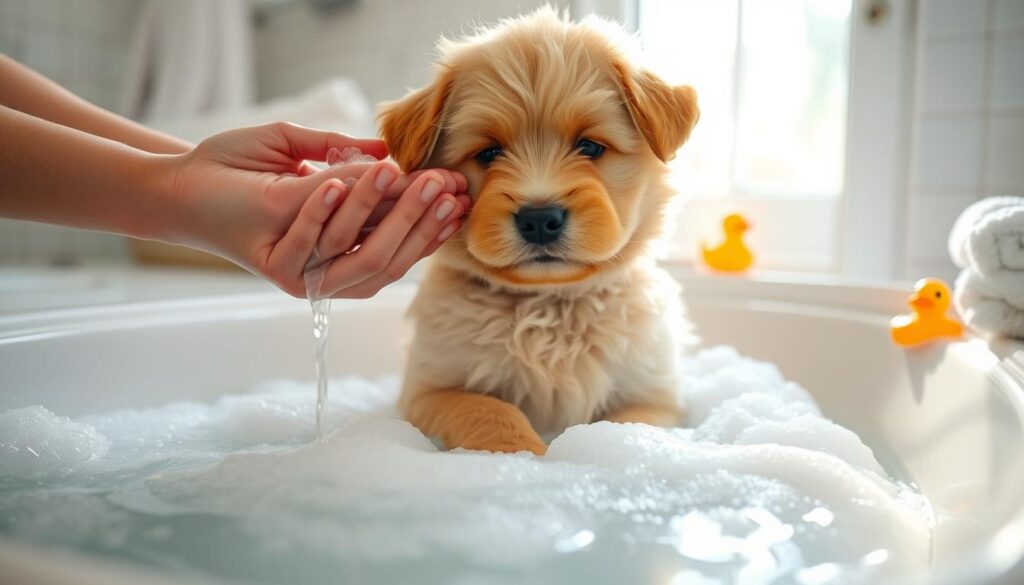
Every puppy is different, and their bath needs can vary. Talk to your vet to make sure you’re using the right puppy bath techniques and products for your puppy’s coat and skin.
Avoid Openings Around the Face
When bathing your puppy, be very careful around the face and sensitive areas. Dogs’ ear canals are shaped like an L. If water gets trapped, it can cause painful ear infections. To avoid this, use only a little product on the face and gently pinch the ear base when cleaning.
Also, don’t let water get into your puppy’s eyes. The eye area is delicate and can get irritated by soap and water. Move carefully around this area, making sure no water or shampoo goes into their eyes. Keeping your puppy safe during baths is key to their health.
- Use minimal product around the face
- Pinch the base of the ear shut when cleaning
- Avoid getting water directly in the eyes
- Approach the eye area with gentle, careful motions
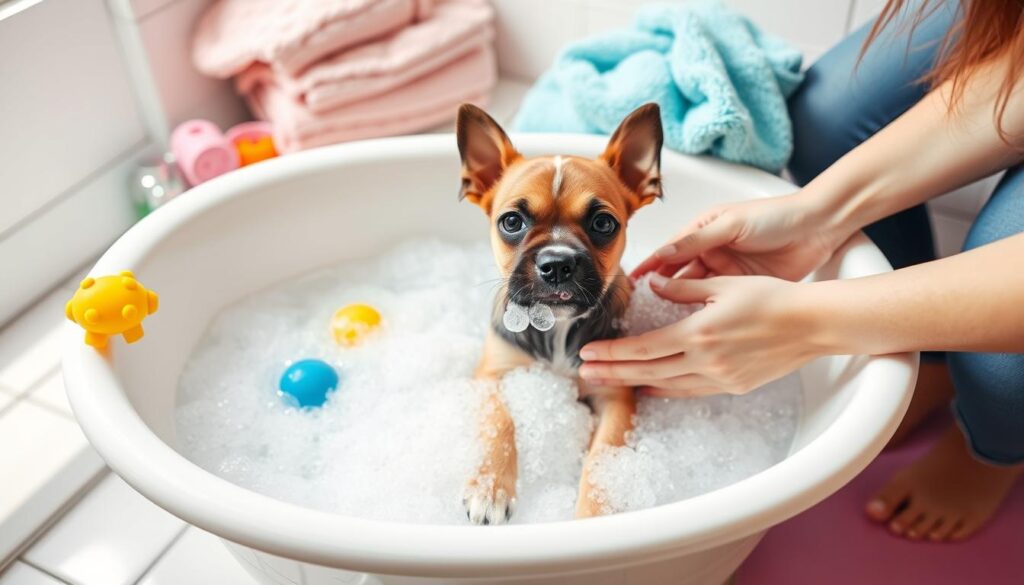
By following these steps, you can make sure your puppy has a safe bath. This protects their sensitive areas and prevents future problems.
Rinse Thoroughly
Bathing your pup needs a good rinse to keep them clean and happy. The final step is removing all shampoo from their coat. Nektar Pooche Dog Shampoo is a great choice, with organic ingredients for health benefits. But, rinsing well is key, no matter the shampoo.
Good bathing keeps your puppy’s skin and coat healthy. It helps prevent skin problems too. Make sure you have everything ready, like a handheld shower, for a smooth bath.
Even when you think you’ve rinsed enough, rinse some more. Rinsing three times from head to toes is important to avoid skin irritation. About 80% of dogs don’t like baths, so make it fun with treats and games.
After rinsing, it’s time for conditioning. Add fun to drying with beach towels or games. With care, your pup will be clean, comfy, and ready for the day.
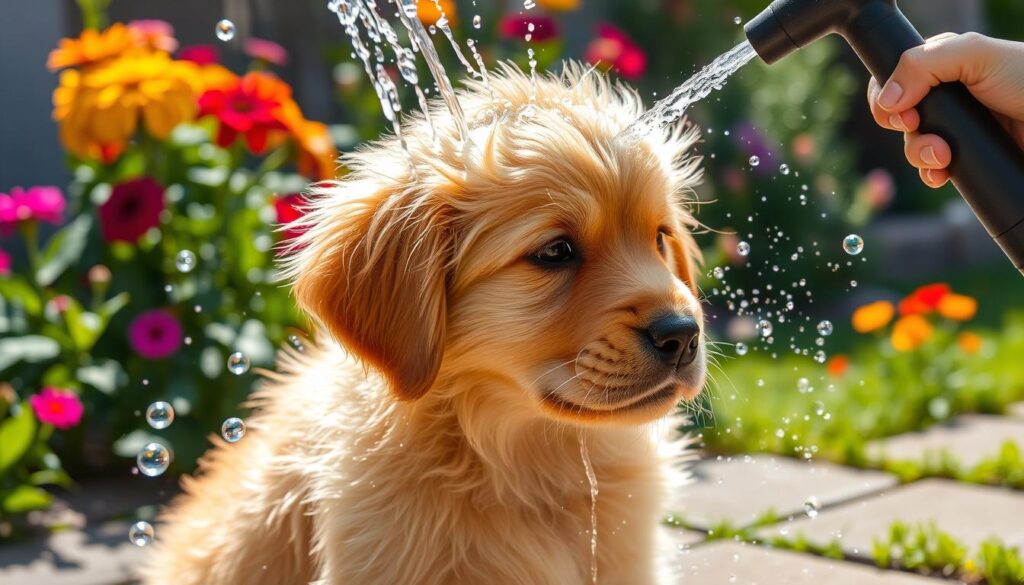
Don’t Forget the Conditioner
Your puppy’s skin and coat are vital. Shampoo can remove essential oils and moisture. This leaves their fur dry and brittle. So, it’s key to use a top-notch puppy conditioner to keep their moisturising dog coat healthy and shiny.
Dogs need conditioner just like humans do. It helps replace the oils lost during bathing. This stops dryness, flakiness, and skin irritation.
- Choose a gentle, moisturising dog conditioner made for puppies.
- Put the conditioner on after shampooing and let it sit for a few minutes before rinsing well.
- Don’t use human conditioners, as they can harm your pup.
Conditioning your puppy’s coat is crucial for their skin and fur health. The right puppy conditioner will make their moisturising dog coat look and feel great.
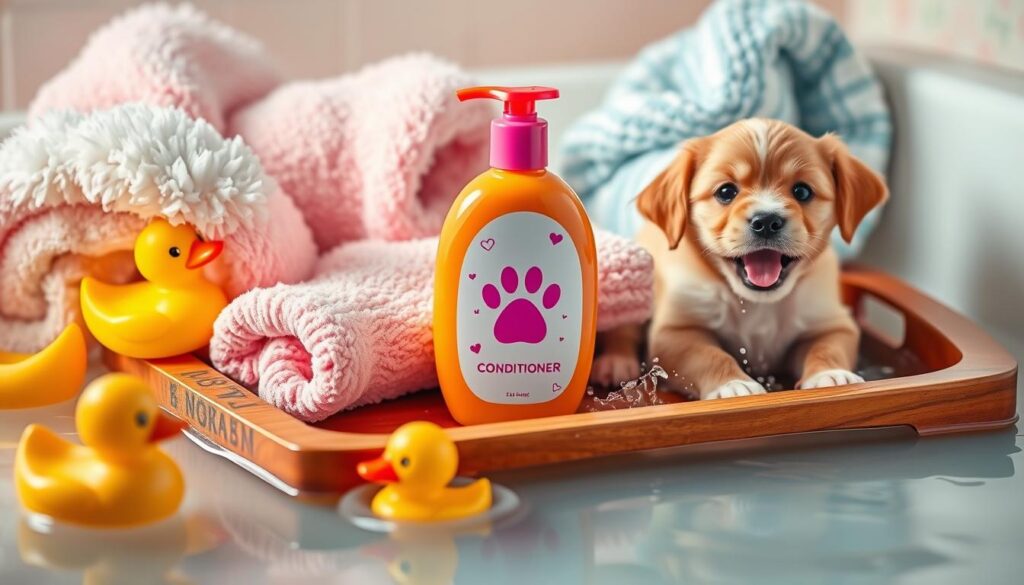
“Dogs’ skin and coats are the most important part of their body. Shampoo strips out moisture, so use conditioner to prevent dryness.”
Blow Dry Time
After rinsing and conditioning your puppy, it’s time to blow-dry their coat gently. Don’t use blow-dry creams or styling aids as they can harm their skin and fur. Instead, use a small handheld blow dryer on the lowest setting for comfort.
While blow-drying, brush your puppy’s hair in the direction it grows. This helps distribute warmth evenly and prevents matting. Be gentle and keep the dryer moving to avoid hot spots.
Using a dog-safe hairdryer and brushing correctly is key to a healthy coat and skin. Your puppy will feel refreshed and ready to play after a bath.
Key Grooming Tips
- Use a small, handheld blow dryer on the lowest setting to gently dry your puppy’s fur
- Brush the hair in the direction it naturally grows to prevent matting and tangles
- Avoid using any blow-dry creams or styling products, as these can be harsh on delicate skin
- Take your time and maintain a gentle touch to ensure a comfortable experience for your pup
| Drying Puppy After Bath | Using a Dog-Safe Hairdryer | Grooming Techniques |
|---|---|---|
| Gently towel-dry to remove excess moisture | Set the dryer to the lowest setting | Brush in the direction of hair growth |
| Avoid rubbing vigorously to prevent skin irritation | Keep the dryer moving to prevent hot spots | Avoid using harsh styling products |
| Supervise the drying process to ensure your puppy’s comfort | Use a small, handheld dryer for better control | Take your time and maintain a gentle touch |
Proper grooming and using dog-safe products are vital for your puppy’s health. Follow these gentle drying and brushing methods for a positive bath-time experience.
“Proper grooming and bathing routines established early on can set the stage for a lifetime of happy, healthy pets.”
Maintain a Bathing Routine
It’s key to have a regular bathing schedule for your dog’s health and happiness. Dogs should be bathed every month to keep their skin and fur clean. Starting early helps your dog get used to grooming and feel more at ease.
The right bathing frequency for dogs depends on their breed, fur type, and environment. You might bathe your dog in a sink, tub, or outside. Always use lukewarm water to keep them comfortable and clean.
After each bath, make sure to dry your dog well to avoid skin problems. Keep them safe during bath time by preventing escapes and never leaving them alone.
Some dogs might only need a bath once a month, but it can change based on their breed and coat type. Dogs shed dander every 30 days, making regular grooming and baths crucial.
Choose dog-specific shampoo and conditioner that matches the pH of a dog’s skin. These products help keep your dog’s coat healthy by hydrating their skin and hair.
If you’re not sure what products are best for your dog, talk to a groomer for advice. Positive reinforcement during baths can make the experience better for your dog.
Puppy care and long-term grooming are closely linked. By establishing a bathing routine early, you ensure your dog enjoys healthy, happy baths for life.
Easy Puppy Bath Routine for New Owners
Bathing your puppy doesn’t have to be stressful. Follow these tips from grooming expert Jennifer Bishop-Jenkins. You can make bath time gentle and fun for both you and your puppy. Be patient, use the right products, and make it a positive experience with treats and cuddles.
Start bathing puppies as young as eight weeks old. This helps create a lifelong routine. Introduce them slowly with treats, swaddling, and cuddling to keep them safe. Dogs’ body temperatures are higher than ours, so they feel temperature differently.
Until they’re three or four months old, just use a warm wash rag. Bathing a puppy under six months is like bathing a human infant. They’re not used to the feeling. Use a soft stream of water and gentle hand motions in the direction of hair growth.
Avoid getting water in their sensitive ear canals. These are shaped like an L and can trap water, leading to infections.
Rinse your dog thoroughly to remove all soap. Rinse even more to get every molecule off. Dogs’ skin and coats are crucial, so use a coat conditioner to prevent dryness after the bath.
- Bathe your puppy monthly to prevent oil and dirt build-up.
- Use puppy-specific shampoo, a gentle brush or comb, and a cool-setting hair dryer.
- Make bath time positive with treats and cuddles to create a lifelong routine.
The key to a successful puppy bath is patience, the right products, and making it positive for your furry friend. With some preparation and care, bath time will be easy for both you and your puppy.
Conclusion
Creating a positive bath time routine is key for your new puppy’s care. Start with the right puppy bath tips and dog grooming guide. Use treats and cuddles to make bath time fun for both of you.
Stick to a monthly bath schedule. This keeps your puppy clean and happy for years.
Teaching your puppy to groom early is vital for their health. Begin the new pet owner advice routine at 8-10 weeks. This builds trust and comfort in grooming.
Use gentle methods and avoid sensitive spots. Always rinse and condition well to keep their coat shiny.
With the right approach, bath time can be a special bonding moment. Watch your Pomeranian puppy grow up clean, happy, and healthy!

